软枣猕猴桃(Actinidia arguta Sieb. et Zucc.)为猕猴桃科猕猴桃属的多年生雌雄异株藤本植物[1],其果实表皮光滑无毛、营养丰富、风味独特,具有较高的食用、药用及经济价值,近年来已逐渐成为各国竞相推广的新兴果树种类。随着产业快速发展,种苗质量不高、栽植成活率低、管理水平低下、产量和品质不高等问题日益成为软枣猕猴桃生产中的限制因素[2]。另外,软枣猕猴桃的根为肉质根,根系较浅,对水分需求更为严苛[2-4],如何合理进行水分管理、提高水分利用率、制定合理灌溉方案正在成为软枣猕猴桃产业关注的热点。
作为一个传统农业大国,中国农业用水占全部用水总量的80%以上[5],但长期存在灌溉水分利用率偏低的问题,仅45%[6],造成水资源极大浪费,而且还有多地常因干旱缺水造成农业大幅减产甚至绝收,可见科学精准用水对保证作物正常生长、高产稳产、稳定品质具有重要意义。
近年来兴起的基质栽培技术与传统技术相比具有高水分利用率、高空间利用率、操作便捷等特点[7-8],该技术不仅大大减少了人力资源投入,还克服了土壤栽培引发的一系列环境问题[9];不但可根据作物特点对生长环境进行合理调控、优化生产环境、提高生产力[10],还可根据作物特点、生态环境等因素,精准控制生长所需水量及时间[11-12]。科学灌溉制度的制定和水资源高效利用,推动传统农业向数字化、精准化和智慧化的变革已成为农业可持续发展的必由之路[13-18]。
笔者在本研究中通过7 种不同水分供应处理,研究其对基质栽培软枣猕猴桃的干、蔓、叶生长的影响,期望筛选出适宜的水分供应方案,为制定基质栽培软枣猕猴桃合理的灌溉方案提供理论依据。
1 材料和方法
1.1 试验地点
试验于2023 年在中国农业科学院郑州果树研究所软枣猕猴桃试验园(113°06′E,34°07′N)进行。
1.2 试验材料
供试材料为中国农业科学院郑州果树研究所选育的软枣猕猴桃品种中红贝7 号(A.arguta‘Zhong Hong Bei No.7’)1 年生植株,2023 年3 月12 日将前一年繁育的以野生软枣猕猴桃为砧木嫁接的中红贝7 号营养袋苗定植在试验园,采用直径60 cm、高度60 cm、厚度1.3 mm 的黑色无纺布圆柱形营养袋进行基质栽培(图1),栽培基质采用普通育苗营养土与草炭按照体积比1∶1均匀混合,株行距为2 m×3 m,采用一干两蔓羽状整形。
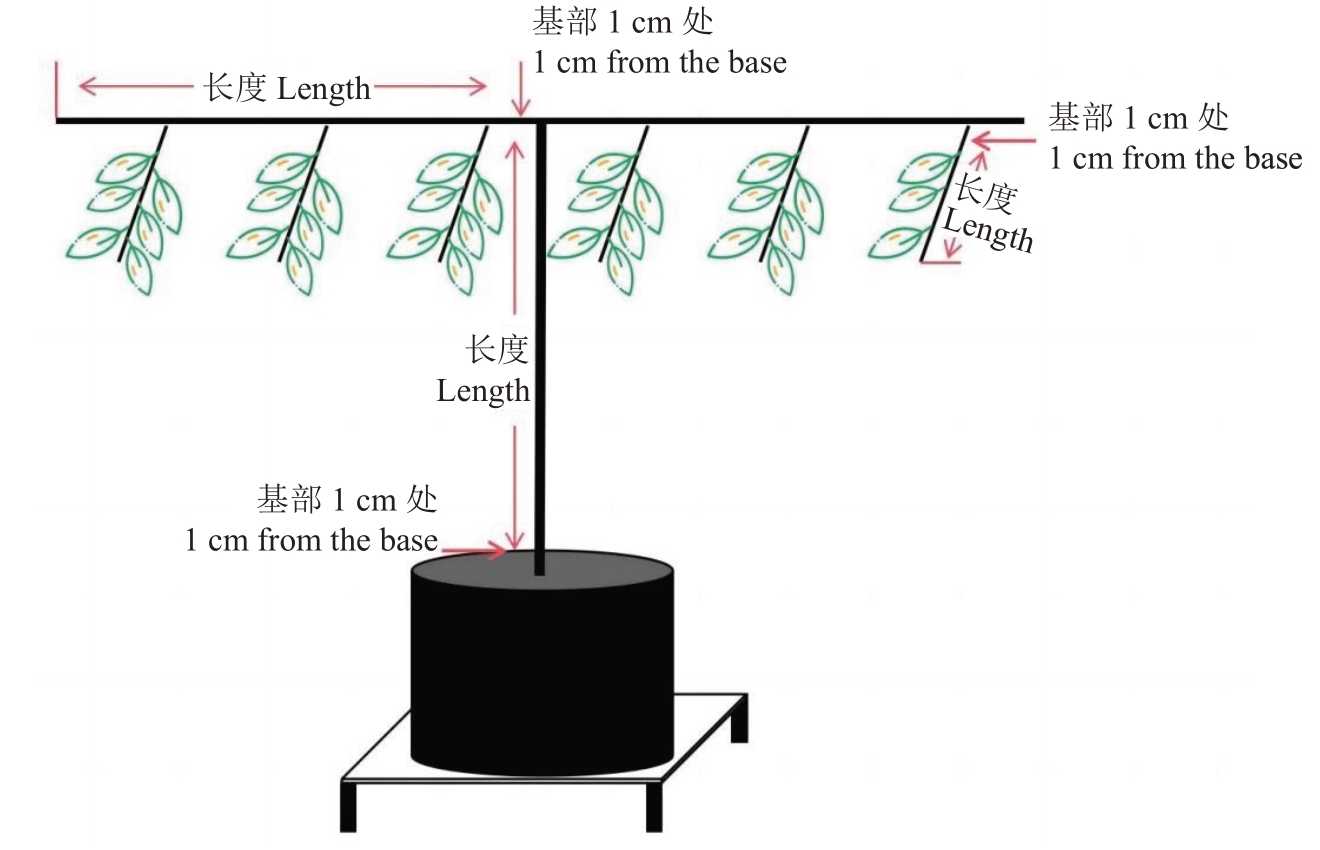
图1 中红贝7 号软枣猕猴桃树形与测量位置
Fig.1 Zhong Hong Bei No.7 structure of kiwifruit
1.3 试验设计
试验共设计7 个供水量处理,分别为基质持水量(saturated moisture content,SMC)的60%(SMC-60%)、70%(SMC-70%)、80%(SMC-80%)、90%(SMC-90%)、100%(SMC-100%)、110%(SMC-110%)、120%(SMC-120%),单株小区,3 次重复。使用水肥一体化智能系统设定灌溉时间,使用不同流量滴箭区分灌水量,统一进行灌溉管理。使用托普云农TP-WSB-02 温室宝(温室环境监测仪)监控基质内温湿度等参数情况,当基质含水量低于设定值时进行补水。
1.4 测定指标与方法
软枣猕猴桃试材两条主蔓南北分布,主蔓上发出的侧蔓向主蔓两侧生长,作为下一年的结果母蔓。侧蔓长至1.5 m 时进行摘心增粗、促进花芽分化。营养袋苗定植84 d后开始测量,主要测定主干、主蔓、结果母蔓和叶片生长情况(图1),在固定位置做好标记,每次均在标记位置进行测量。两次测量间隔25 d,一年共测量6次(6—10月),标记为T1~T6。
植株生长特性测定:对试验株主干、南北两条主蔓基部1 cm处进行标记,随后对所标记主蔓由基部至梢头,依照发梢顺序在第1~2条、第3~4条以及第5~6条位置上各随机标记1条结果母蔓;使用卷尺和数显游标卡尺分别测量主干、主蔓和结果母蔓的长度以及基部1 cm处的茎粗度,统计净增长量。
叶片功能测定:在每条标记结果母蔓上的第3~6枚叶片中随机选取1枚叶片进行标记,使用托普云农TYS-4N(FO2)植物养分测定仪测量叶片大小、厚度、叶绿素相对含量(SPAD值)、氮含量指标等。
1.5 数据处理与分析
采用Microsoft Excel 2019 统计分析试验数据,使用IBM SPSS Statistics 23.0 进行差异显著性检验(LSD 法,p<0.05)和相关性分析,使用Origin 2019软件作图。
2 结果与分析
2.1 不同供水量对软枣猕猴桃1年生植株主干粗度的影响
软枣猕猴桃主干粗度净增长量随基质持水量提高在SMC-110%时达到最大(图2),SMC-60%处理的增长幅度最小,净增长量差异显著(p<0.01)。主干粗度净增长在SMC-110%达到最大后开始下降,相较于其他处理分别提高了188%(SMC-60%)、137%(SMC-70%)、106%(SMC-80%)、28%(SMC-90%)、14%(SMC-100%)、30%(SMC-120%)。
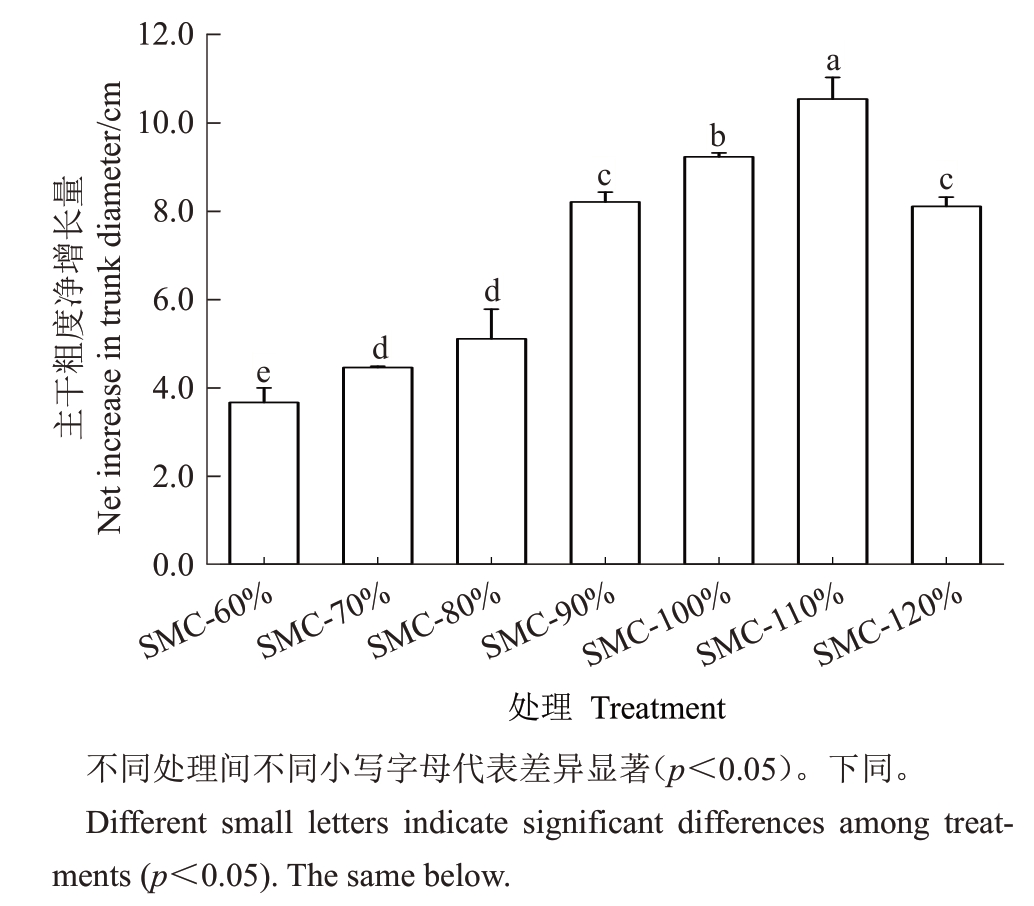
图2 不同供水量对中红贝7 号软枣猕猴桃植株主干粗度净增长量的影响
Fig.2 Net increase in roughness of Zhong Hong Bei No.7 kiwifruit’s trunk diameter under the different water supply
对比每两次调查间指标净增长量(图3),基质持水量SMC-60%以上时,试验植株在T2(6 月中下旬)、T4(7月下旬至8月中旬)、T5(8月下旬至9月中旬)时主干粗度净增长量涨幅较大,为快速生长期。T3(7月初)、T6(10月下旬)时涨幅较小,为缓慢增长期。基质含水量较低情况下即在SMC-60%时,仅在T2时有较大增长。

图3 不同供水量对中红贝7 号软枣猕猴桃主干粗度季度净增长量的影响
Fig.3 Quarterly net increase in roughness of Zhong Hong Bei No.7 kiwifruit’s trunk diameter under the different water supply
2.2 不同供水量对中红贝7号软枣猕猴桃主蔓长度和粗度的影响
软枣猕猴桃主蔓净增长量随基质持水量提高呈上升趋势(图4),SMC-110%和SMC-120%处理的主蔓长度和粗度净增长量相较于其他处理显著增加,不同处理间存在显著差异(p<0.05)。软枣猕猴桃主蔓长度和粗度的净增长量均在SMC-120%达到最大。
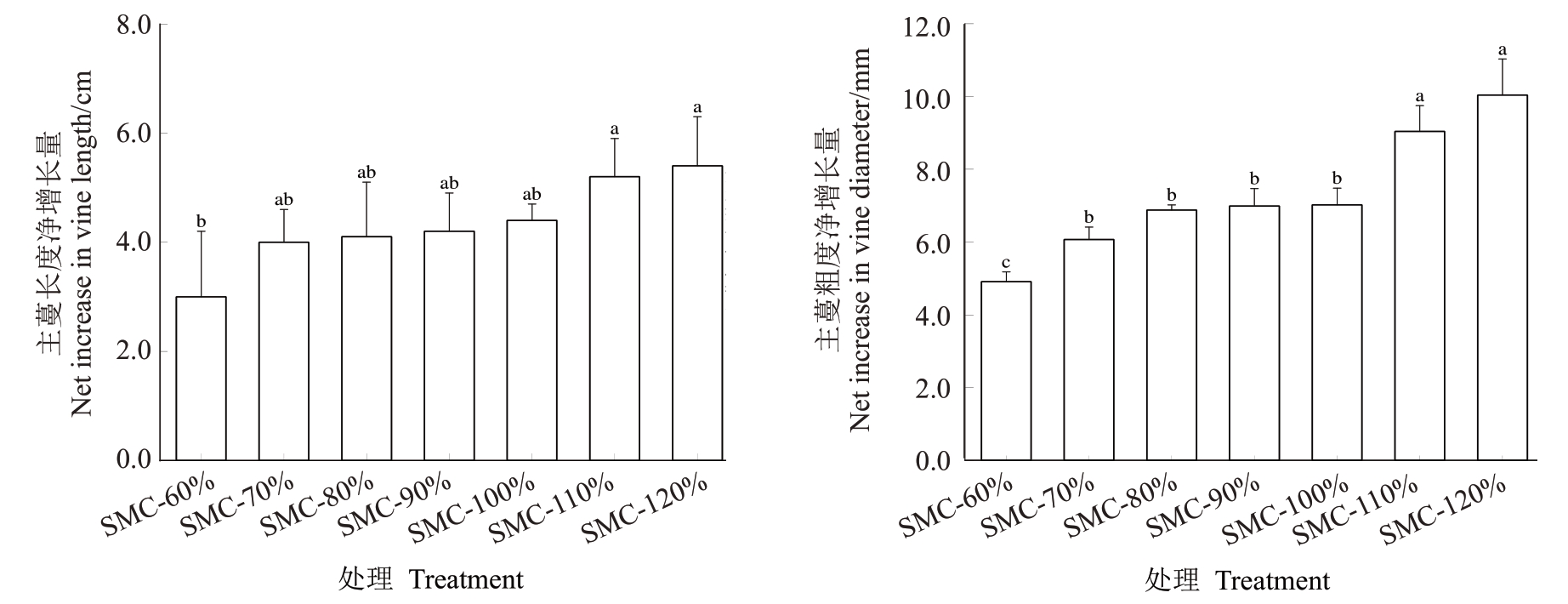
图4 不同供水量对中红贝7 号软枣猕猴桃主蔓长度和粗度净增长量的影响
Fig.4 Net increase in length and roughness of Zhong Hong Bei No.7 kiwifruit’s vine growth under the different water supply
对比每两次调查间主蔓长度、粗度净增长量(图5),在T2(6月中下旬)、T4(7月下旬至8月中旬)、T5(8 月下旬至9 月中旬)时涨幅较大,此为快速生长期。而在T3(7 月初)、T6(10 月下旬)涨幅相对较小,为缓慢生长期。

图5 不同供水量对中红贝7 号软枣猕猴桃主蔓长度和粗度季度净增长量的影响
Fig.5 Quarterly net increasein length and roughness of Zhong Hong Bei No.7 kiwifruit’s vine growth under the different water supply
2.3 不同供水量对软枣猕猴桃植株结果母蔓长度和粗度的影响
当结果母蔓长至1.5 m后进行摘心或剪梢,抑制其生长。在分析该指标时选取摘心前一次数据。结果母蔓长度的净增长量趋势随基质持水量增加呈现先上升后下降的趋势(图6),SMC-100%最大,不同供水量处理间均无显著差异。结果母蔓粗度的净增长量随着基质持水量的提高而提高,SMC-60%表现最差,SMC-120%表现最好,低供水量处理(SMC-60%、SMC-70%、SMC-80%)与充足水分处理(SMC-100%、SMC-110%、SMC-120%)间存在显著差异。
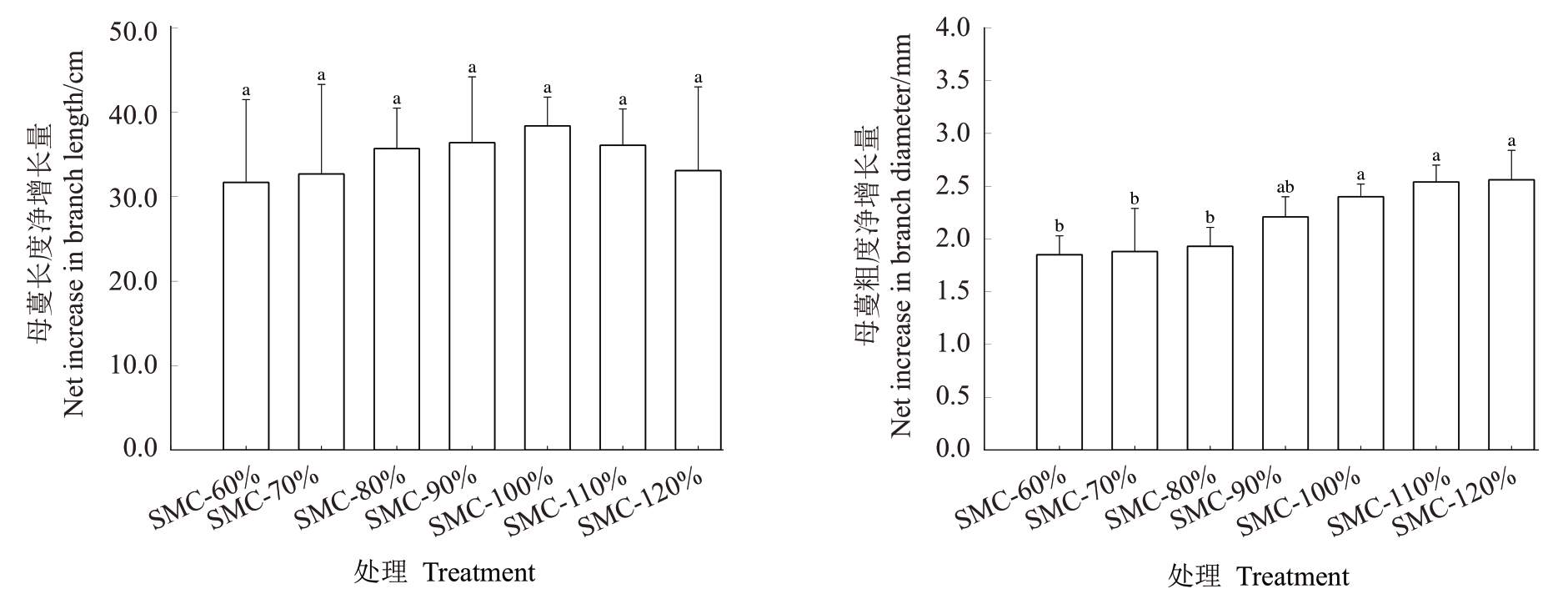
图6 不同供水量处理对中红贝7 号软枣猕猴桃结果母蔓长度和粗度净增长量的影响
Fig.6 Net increase in length and roughness of Zhong Hong Bei No.7 kiwifruit’s branch growth under the different water supply
如图7所示,结果母蔓粗度净增长量在T3、T4(7月至8月中旬)时涨幅较大,为母蔓粗度的快速增长期。在T2(6月中下旬)、T5(8月下旬至9月中旬)、T6(10月下旬)时涨幅相对较小,为缓慢生长期。
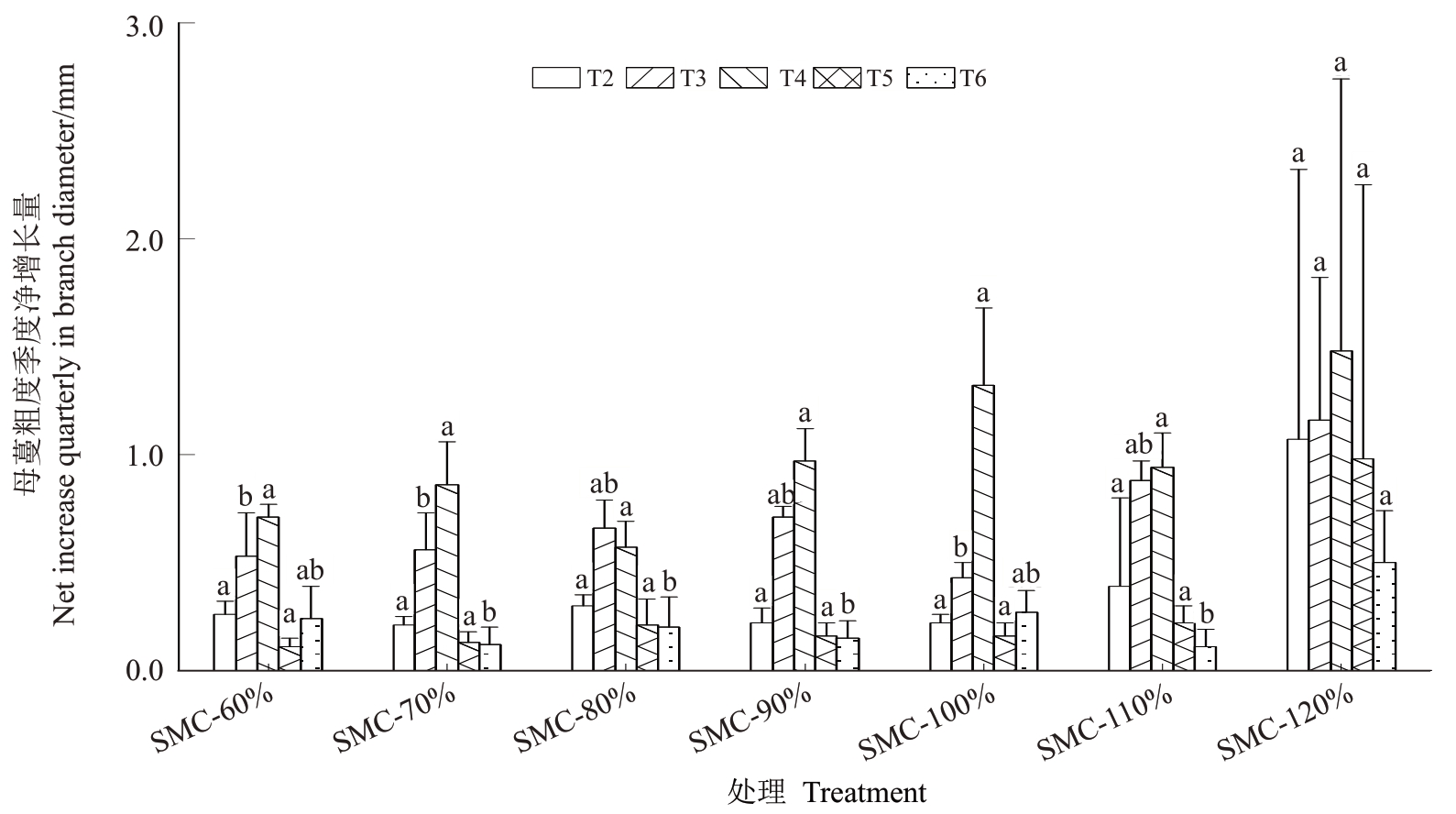
图7 不同供水量处理对中红贝7 号软枣株猕猴桃结果母蔓粗度季度净增长量的影响
Fig.7 Quarterly net increase in length and roughness of Zhong Hong Bei No.7 kiwifruit’s branch growth under the different water supply
2.4 不同供水量对软枣猕猴桃叶片生长及生理特性的影响
各供水量处理下,叶片面积、厚度均呈上升趋势,其中SMC-80%处理的叶片面积净增长量最大,SMC-110%的最小。低供水量(SMC-60%、SMC-70%、SMC-80%、SMC-90%)处理的叶厚净增长量整体大于充足水分(SMC-100%、SMC-110%、SMC-120%)处理的。
不同处理间叶片厚度净增长量无显著差异,在基质持水量较低(SMC-60%、SMC-70%、SMC-80%)时该指标大于充足水分(SMC-100%、SMC-110%、SMC-120%)情况下的净增长量(图8)。对比每两次叶面积、厚度净增长量(图9),叶面积在T2、T3、T6时涨幅较大,为叶面积快速生长期,叶片厚度在T2、T5、T6时涨幅较大,为叶片厚度的快速生长期。综上,T2(6月中下旬)、T6(10月下旬)时为叶片的快速生长期。
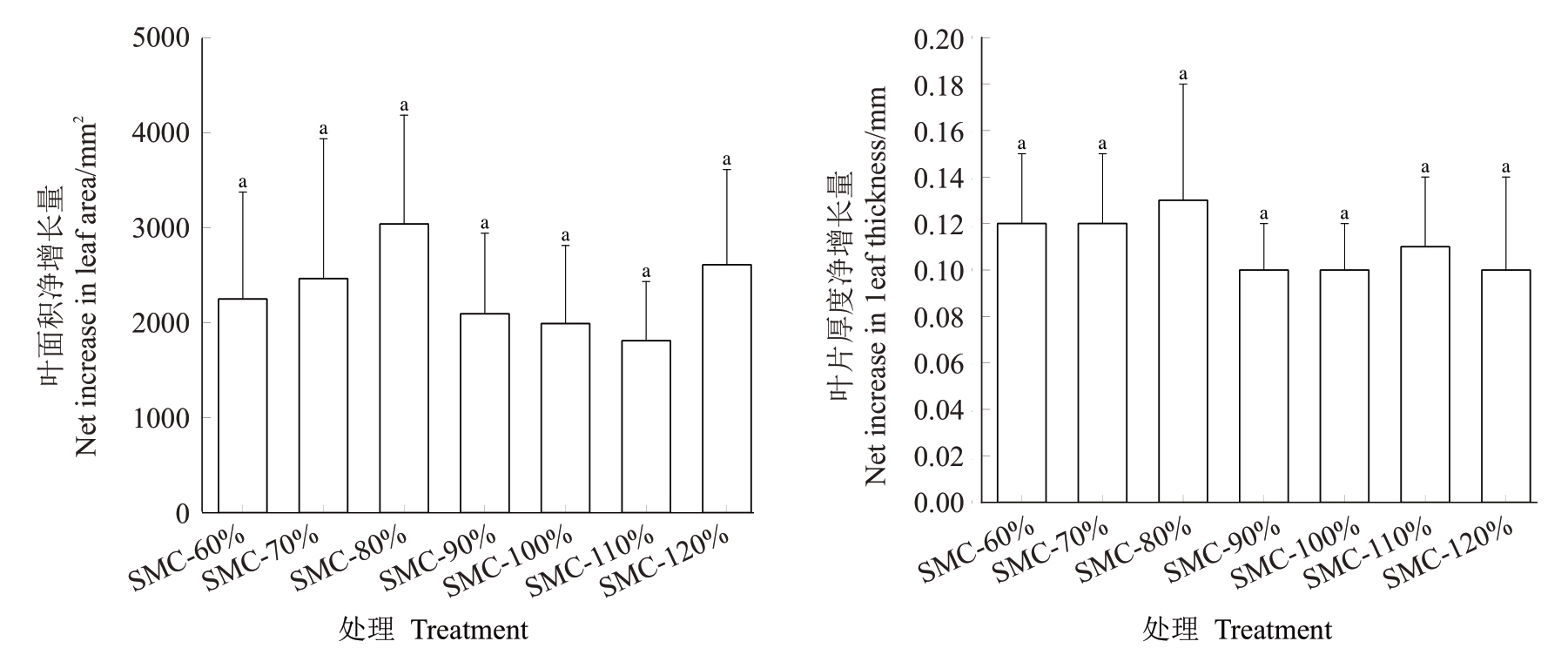
图8 不同供水量对中红贝7 号软枣猕猴桃叶片大小、厚度净增长量的影响
Fig.8 Net increase of Zhong Hong Bei No.7 kiwifruit’s leaf growth under the different water supply
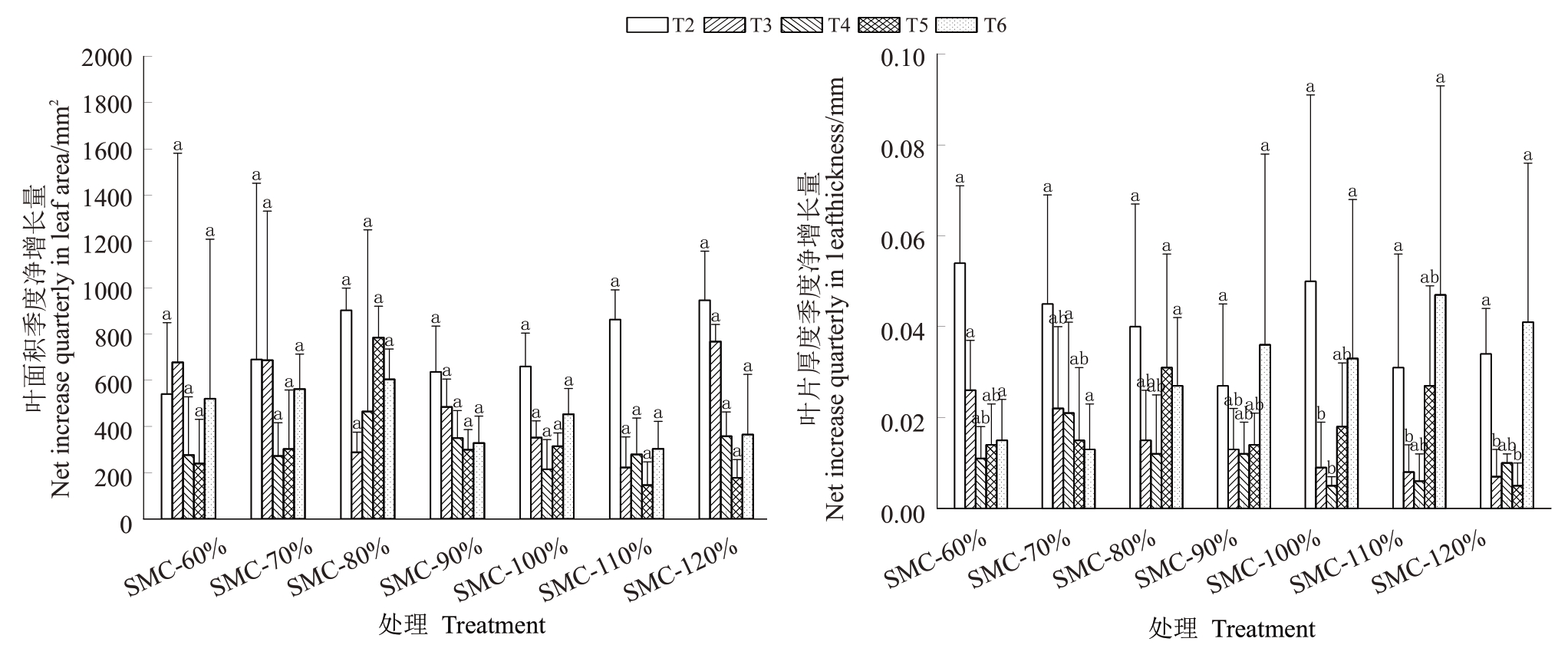
图9 不同供水量对中红贝7 号软枣猕猴桃叶片大小、厚度季度净增长量的影响
Fig.9 Quarterly net increase of Zhong Hong Bei No.7 kiwifruit’s leaf growth under the different water supply
图10可以看出不同水分处理下的叶片叶绿素相对含量(SPAD值)、氮含量在第一次(T1)测量时数值差异较大,后均呈快速上升趋势;不同水分处理下叶片SPAD 值和氮含量分别在T2、T3 时缓慢下降,最后分别在T5或T6时缓慢上升并处在较高水平。T6时各处理间SPAD 值、氮含量差异不明显,且同一处理下叶片SPAD值和氮含量变化趋势基本一致。

图10 不同供水量条件下中红贝7 号软枣猕猴桃叶片叶绿素相对含量(SPAD 值)、氮含量变化趋势
Fig.10 Changes in chlorophyll relative content(SPAD value)and nitrogen content trends of Zhong Hong Bei No.7 kiwifruit under different water treatments
3 讨 论
水是植物细胞的主要组成部分,水分通过根系吸收直接参与植物代谢活动,是植物进行光合作用的重要原料;同时充当所需矿质元素的运输载体,为植物提供受压支持并促进物质运输。适宜的水分供应有利于植物正常的生理活动与代谢,而水分过多会对植物生理机制造成伤害[19-22]。同样,存在严重水分胁迫时,也会导致长势减弱、茎蔓生长受到抑制[23-25];因此,某种程度上来说植物的高度和粗度等外观性状可以直观反映出水分的供应状况[26]。
在本研究中,1年生中红贝7号软枣猕猴桃在基质水分含量较低或超过基质持水量时的主干、主蔓以及结果母蔓的长度和粗度等外观性状均受到明显影响。当基质持水量较高如在120%时,主蔓的长度和粗度以及母蔓粗度净增长量最大。而主干粗净增长量比最大净增长量少了23%,母蔓长净增长量比最大净增长量少了8.3%。在低基质持水量如在60%时,此时植株生长净增长量最小;相较于最大净增长量主干粗度、主蔓以及母蔓长度和粗度分别减少了65%、50%和21%以及18%和31%。这与前人在桃[27]、刺槐[28]上的研究结果类似。同时,低水分供应导致叶片正常功能会受到一定程度的损害,叶绿素含量减少、光合速率降低,且降低幅度与水分胁迫的严重程度呈正相关[29];轻度干旱对生长无明显影响,反而会提高作物的水分利用率和光合速率[30-33]。这与本研究中叶片表现结果一致,较低水分处理下的叶片优于充足水分处理时的生长表现,叶片SPAD值与氮含量受不同程度影响,其趋势表明低水分处理的叶片SPAD值和氮含量变化响应更为迅速。而叶面积、叶片厚度净增长量在不同供水量条件下,并未遵循随基质水分提高而逐步提高的规律,这是否与试材使用遮阳网防晒有关,还需进一步探究。
4 结 论
不同供水量对1 年生基质栽培中红贝7 号软枣猕猴桃的生长影响差异显著,在基质含水量110%、120%处理下主干、蔓、母蔓长度、粗度和叶片等生长指标净增长量综合表现较好,可作为基质栽培软枣猕猴桃适宜的水分管理方案。
[1] PINTO D,DELERUE-MATOS C,RODRIGUES F.Bioactivity,phytochemical profile and pro-healthy properties of Actinidia arguta:A review[J]. Food Research International,2020,136:109449.
[2] 齐秀娟,郭丹丹,王然,钟云鹏,方金豹.我国猕猴桃产业发展现状及对策建议[J].果树学报,2020,37(5):754-763.QI Xiujuan,GUO Dandan,WANG Ran,ZHONG Yunpeng,FANG Jinbao. Development status and suggestions on Chinese kiwifruit industry[J]. Journal of Fruit Science,2020,37(5):754-763.
[3] 张效星,樊毅,崔宁博,李晨,胡笑涛,龚道枝.不同灌水量对滴灌猕猴桃光合、产量与水分利用效率的影响[J].灌溉排水学报,2019,38(1):1-7.ZHANG Xiaoxing,FAN Yi,CUI Ningbo,LI Chen,HU Xiaotao,GONG Daozhi. The effects of drip-irrigation amount on photosynthesis,yield and water use efficiency of kiwifruit[J].Journal of Irrigation and Drainage,2019,38(1):1-7.
[4] 甘雨康,施浩然,崔宁博,康佳辉.不同微灌方式下水分调控对猕猴桃光合特性及产量的影响[J].灌溉排水学报,2020,39(4):17-25.GAN Yukang,SHI Haoran,CUI Ningbo,KANG Jiahui. Effects of water regulation on photosynthetic characteristics and yield of kiwifruit leaves under different micro-irrigation methods[J].Journal of Irrigation and Drainage,2020,39(4):17-25.
[5] 罗良国,任爱胜,王瑞梅,郭鸿鹏.我国农业可持续发展的水危机及广泛开展节水农业前景初探[J].节水灌溉,2000(5):6-9.LUO Liangguo,REN Aisheng,WANG Ruimei,GUO Hongpeng.An elementary study on water resource crisis and agricultural WS foreground for agriculture sustainable development in China[J].Water Saving Irrigation,2000(5):6-9.
[6] 梁金霞.现代节水农业技术探讨[J].现代农业科技,2022(23):139-142.LIANG Jinxia. Discussion on modern water-saving agricultural technology[J]. Modern Agricultural Science and Technology,2022(23):139-142.
[7] 谢小玉,邹志荣,江雪飞,妙晓莉.中国蔬菜无土栽培基质研究进展[J].中国农学通报,2005,21(6):280-283.XIE Xiaoyu,ZOU Zhirong,JIANG Xuefei,MIAO Xiaoli. Research advances of substrates in soil-less culture of vegetables in China[J]. Chinese Agricultural Science Bulletin,2005,21(6):280-283.
[8] 晏琼,刘晓宇,虞昊安,李翎慈,刘潇漪,张育新,戴昊鸣,陈斯琳,成喜雨.植物无土栽培技术研究进展[J].中国农业大学学报,2022,27(5):1-11.YAN Qiong,LIU Xiaoyu,YU Haoan,LI Lingci,LIU Xiaoyi,ZHANG Yuxin,DAI Haoming,CHEN Silin,CHENG Xiyu.Recent advances in plant soilless cultivation[J]. Journal of China Agricultural University,2022,27(5):1-11.
[9] 孙锦,李谦盛,岳冬,高洪波,康云艳,田婧,李晶,郭世荣.国内外无土栽培技术研究现状与应用前景[J].南京农业大学学报,2022,45(5):898-915.SUN Jin,LI Qiansheng,YUE Dong,GAO Hongbo,KANG Yunyan,TIAN Jing,LI Jing,GUO Shirong.Research status and application prospects of soilless culture technology in the world[J].Journal of NanjingAgricultural University,2022,45(5):898-915.
[10] 殷学云,张国森,刘华.戈壁日光温室西葫芦—菜豆有机生态型无土栽培技术[J].中国蔬菜,2020(11):113-115.YIN Xueyun,ZHANG Guosen,LIU Hua. Gobi solar greenhouse zucchini-bean organic ecotype soilless cultivation technology[J].China Vegetables,2020(11):113-115.
[11] 张晓斌,冯俊杰,刘杨,韩启彪,娄和,王明.灌溉流量自调节阀的结构设计与性能分析[J].节水灌溉,2020(6):56-60.ZHANG Xiaobin,FENG Junjie,LIU Yang,HAN Qibiao,LOU He,WANG Ming.Structural design and performance analysis of irrigation flow auto-regulating valve[J].Water Saving Irrigation,2020(6):56-60.
[12] 崔文军,李大山,刘祖贵,张寄阳,高阳,申孝军.几种墒情监测设备的测量精度对比研究[J].中国农村水利水电,2014(5):61-63.CUI Wenjun,LI Dashan,LIU Zugui,ZHANG Jiyang,GAO Yang,SHEN Xiaojun.An analysis of measuring accuracy of different kinds of soil moisture monitoring equipment[J].China Rural Water and Hydropower,2014(5):61-63.
[13] ALIZADEH Z,GHASEMNEZHAD M,SANGANI M F,ATAK A. The effects of high concentration of bicarbonate applications on kiwifruit genotypes with different ploidy levels on some growth parameters of leaves[J]. Turkish Journal of Agriculture and Forestry,2023,47(4):436-447.
[14] PUROHIT S,RAWAT J M,PATHAK V K,SINGH D K,RAWAT B.A hydroponic-based efficient hardening protocol for in vitro raised commercial kiwifruit (Actinidia deliciosa)[J]. In Vitro Cellular & Developmental Biology- Plant,2021,57(3):541-550.
[15] PENG D D,CHEN D G,XU K W,PENTTINEN P,YOU H Y,LIAO H P,YANG R,CHEN Y X. Optimal substrate moisture content for kiwifruit (Actinidia valvata Dunn) seedling growth based on analyses of biomass,antioxidant defense,and photosynthetic response[J].Agronomy,2023,13(7):1858.
[16] WOZNICKI T,KUSNIEREK K,VANDECASTEELE B,SØNSTEBY A.Reuse of coir,peat,and wood fiber in strawberry production[J].Frontiers in Plant Science,2024,14:1307240.
[17] ŞIRIN U,ERTAN E,ERTAN B.Growth substrates and fig nursery tree production[J].Scientia Agricola,2010,67(6):633-638.
[18] 李智琪,李晴,董相洁,乜兰春,赵文圣,赵丽平,王磊,刘淑芹.以醋糟为主要成分的无土栽培基质筛选及其对甜瓜生长和果实品质的影响[J].山东农业科学,2023,55(9):72-78.LI Zhiqi,LI Qing,DONG Xiangjie,NIE Lanchun,ZHAO Wensheng,ZHAO Liping,WANG Lei,LIU Shuqin. Selection of soilless cultivation substrate with vinegar dregs as main component and its effect on melon growth and fruit quality[J]. Shandong Agricultural Sciences,2023,55(9):72-78.
[19] 邓辉茗,龙聪颖,蔡仕珍,宋宇,鄢如霞,车亦然,王长见,肖瑶.不同水分胁迫对绵毛水苏幼苗形态和生理特性的影响[J].西北植物学报,2018,38(6):1099-1108.DENG Huiming,LONG Congying,CAI Shizhen,SONG Yu,YAN Ruxia,CHE Yiran,WANG Changjian,XIAO Yao. Morphology and physiological characteristics of Stachys lanata seedling under water stress[J]. Acta Botanica Boreali-Occidentalia Sinica,2018,38(6):1099-1108.
[20] 王佳岚,李春杰.不同水分梯度对碱茅农艺性状的影响[J].草地学报,2021,29(7):1584-1588.WANG Jialan,LI Chunjie.Effect of different water gradients on agronomic characters of Puccinellia distans[J].Acta Agrestia Sinica,2021,29(7):1584-1588.
[21] 钟海霞,张付春,潘明启,张雯,韩守安,谢辉,王敏,周晓明,艾尔买克·才卡斯木,伍新宇.不同灌水量对赤霞珠葡萄光合作用的影响[J].新疆农业科学,2020,57(3):492-497.ZHONG Haixia,ZHANG Fuchun,PAN Mingqi,ZHANG Wen,HAN Shouan,XIE Hui,WANG Min,ZHOU Xiaoming,Ermek·Cakasim,WU Xinyu. Effects of different irrigation amounts on photosynthesis of Cabernet Sauvignon grapes[J]. Xinjiang Agricultural Sciences,2020,57(3):492-497.
[22] CALVO F E,TRENTACOSTE E R,SILVENTE S T.Vegetative growth,yield,and crop water productivity response to different irrigation regimes in high density walnut orchards (Juglans regia L.) in a semi-arid environment in Argentina[J].Agricultural Water Management,2022,274:107969.
[23] HUSSAIN M,MALIK M A,FAROOQ M,ASHRAF M Y,CHEEMA M A. Improving drought tolerance by exogenous application of glycinebetaine and salicylic acid in sunflower[J].Journal of Agronomy and Crop Science,2008,194(3):193-199.
[24] 张玉,冷海楠,曹宏杰,徐明怡.干旱胁迫对植物的影响研究[J].黑龙江科学,2022,13(14):22-24.ZHANG Yu,LENG Hainan,CAO Hongjie,XU Mingyi. Study on the influence of drought stress on botany[J]. Heilongjiang Science,2022,13(14):22-24.
[25] 马福林,马玉花. 干旱胁迫对植物的影响及植物的响应机制[J].宁夏大学学报(自然科学版),2022,43(4):391-399.MA Fulin,MA Yuhua. Effect of drought stress on plants and their response mechanism[J]. Journal of Ningxia University(Natural Science Edition),2022,43(4):391-399.
[26] 陆日惠,徐力兴,周晓星,盛世红,冯晨,陈钏,唐丽.淹水胁迫对福建山樱花幼苗生长和光合特性的影响[J].江西农业大学学报,2022,44(4):871-881.LU Rihui,XU Lixing,ZHOU Xiaoxing,SHENG Shihong,FENG Chen,CHEN Chuan,TANG Li. Effects of flooding stress on growth and photosynthesis of Cerasus campanulate seedlings[J].Acta Agriculturae Universitatis Jiangxiensis,2022,44(4):871-881.
[27] WANG D,ZHANG H H,GARTUNG J. Long-term productivity of early season peach trees under different irrigation methods and postharvest deficit irrigation[J].Agricultural Water Management,2020,230:105940.
[28] 唐洋,温仲明,王杨,刘静.土壤水分胁迫对刺槐幼苗生长、根叶性状和生物量分配的影响[J].水土保持通报,2019,39(6):98-105.TANG Yang,WEN Zhongming,WANG Yang,LIU Jing.Effects of soil water stress on growth,root and leaf traits,and biomass allocation of Robinia pseudoacacia seedlings[J].Bulletin of Soil and Water Conservation,2019,39(6):98-105.
[29] 王海珍,韩路,徐雅丽,牛建龙,于军.土壤水分梯度对灰胡杨光合作用与抗逆性的影响[J].生态学报,2017,37(2):432-442.WANG Haizhen,HAN Lu,XU Yali,NIU Jianlong,YU Jun.Effects of soil water gradient on photosynthetic characteristics and stress resistance of Populus pruinosa in the Tarim Basin,China[J].Acta Ecologica Sinica,2017,37(2):432-442.
[30] PÉREZ-ÁLVAREZ E P,INTRIGLIOLO M D S,VIVALDI G A,GARCÍA-ESPARZA M J,LIZAMA V,ÁLVAREZ I. Effects of the irrigation regimes on grapevine cv.Bobal in a Mediterranean climate:I.water relations,vine performance and grape composition[J].Agricultural Water Management,2021,248:106772.
[31] PENG S Z,GAO X L,YANG S H,YANG J,ZHANG H X.Water requirement pattern for tobacco and its response to water deficit in Guizhou Province[J]. Water Science and Engineering,2015,8(2):96-101.
[32] 梁银丽,康绍忠. 节水灌溉对冬小麦光合速率和产量的影响[J].西北农业大学学报,1998,26(4):16-19.LIANG Yinli,KANG Shaozhong.Effects of water saving irrigation on photosynthesis and yield of winter wheat(Triticum aestivum L.)[J]. Acta University Agriculture Boreali-occidentalis,1998,26(4):16-19.
[33] GONZALEZ-DUGO V,RUZ C,TESTI L,ORGAZ F,FERERES E. The impact of deficit irrigation on transpiration and yield of mandarin and late oranges[J]. Irrigation Science,2018,36(4):227-239.